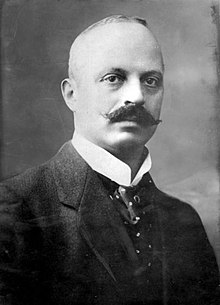Roman Catholic State Party
Roman Catholic State Party Roomsch-Katholieke Staatspartij | |
|---|---|
Elections |
The Roman Catholic State Party (
History

The RKSP was founded 3 June 1926, as the continuation of the
During the 1920s and the 1930s, the RKSP was the biggest party in the Netherlands, receiving a steady 30% percent of the vote at each election. During this entire period the party was in government, in coalition with the
The cooperation with the ARP and CHU was problematic. In 1925 the Ruijs de Beerenbrouck cabinet was composed of the ARP, the CHU and the General League fell over the Dutch representation at the Holy See. This issue continued to divide the RKSP and the CHU and the ARP, as did the prohibition of traditional marches by Catholic churches and the role of government in the economy. The second Colijn cabinet fell because the RKSP wanted a more interventionist economic policy, but that cabinet was restored. In 1939, however, the fourth Colijn cabinet fell again on economic policy. In 1939, a coalition of RKSP, CHU, Free-thinking Democratic League (VDB) and Social Democratic Workers' Party (SDAP) ended more than 20 years of Coalition government.
After World War II, the RKSP was replaced by the Catholic People's Party.
Ideology
The RKSP based on biblical norms and
The party was a staunch proponent of a
Regarding foreign affairs, the RKSP was an advocate of Dutch neutrality, which was to be maintained by a strong army and navy. Furthermore, the party was in favour of the colonial government of the Dutch East Indies.
Electoral performance
| Election | Votes | Seats | Position | Government | ||
|---|---|---|---|---|---|---|
| # | % | # | ± | |||
| 1929 | 1,001,589 | 29.6 | 30 / 100
|
Coalition | ||
| 1933 | 1,037,364 | 27.9 | 28 / 100
|
Coalition | ||
| 1937 | 1,170,431 | 28.8 | 31 / 100
|
Coalition | ||
Linked organisations
The KVP had close links to many other Catholic institutions such as the
Important figures
The Limburg-based priest Weil Nolens led the party since its foundation, till his death in 1931.
The former professor and minister
Other prominent figures were
Electorate
The RKSP was supported by Catholics of all classes. In North Brabant and Limburg, it often got more than 90% of the vote.
References
- ISBN 978-1-137-31484-0.
Literature
- Roes, Jan (2004). Kaiser, Wolfram; Wohnout, Helmut (eds.). A Historical Detour: The Roman Catholic State Party in the Netherlands. Routledge. pp. 65–76. )
External links
 Media related to Rooms-Katholieke Staatspartij at Wikimedia Commons
Media related to Rooms-Katholieke Staatspartij at Wikimedia Commons
